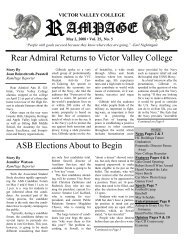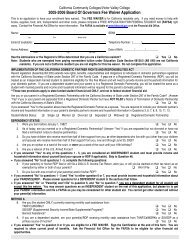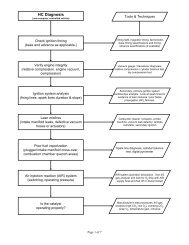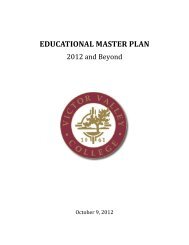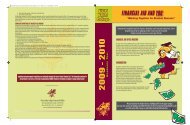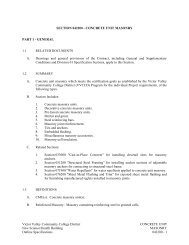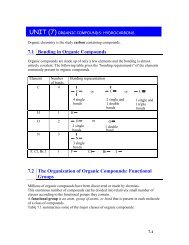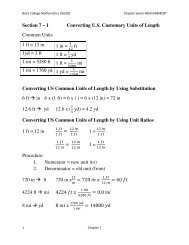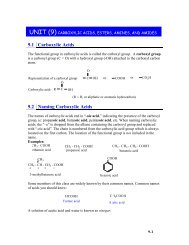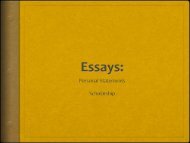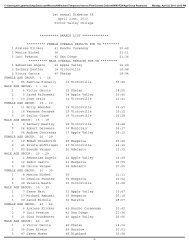Download - Victor Valley College
Download - Victor Valley College
Download - Victor Valley College
You also want an ePaper? Increase the reach of your titles
YUMPU automatically turns print PDFs into web optimized ePapers that Google loves.
PROGRAMS / COURSE DESCRIPTION<br />
Students learn the common environmental factors that<br />
may cause digestive health problems like colic and<br />
diarrhea. Emphasis is placed on a balanced diet and<br />
proper feeding practices.<br />
AGNR 50D EQUINE LAMENESS; LAMINITIS,<br />
NAVICULAR AND BEYOND<br />
Units: 0.5 - 8-9 hours lecture. (No prerequisite. Grade<br />
Option)<br />
Students assess the pathogenesis of navicular Disease<br />
and Laminitis; describe common methods of treatment;<br />
evaluate the impact of these and other lameness on the<br />
athletic potential of the equine athlete. Techniques for<br />
diagnosis (radiography, ultrasound) and treatment<br />
(chiropractic, drugs) are explored.<br />
AGNR 50E EQUINE REPRODUCTIVE HEALTH<br />
Unit: 0.5 - 8-9 hours lecture. (No prerequisite. Grade<br />
Option)<br />
The unusual reproductive conformation of the mare and<br />
the stallion and breeding practices has produced an<br />
inordinately low level of reproductive efficiency in<br />
modern horse breeds. Course presents the appropriate<br />
use of recent management and technology innovations:<br />
progesterone therapy, increased day-length, ultrasonic<br />
imaging, artificial insemination, cooled semen and<br />
embryo transfer.<br />
AGNR 50F EQUINE FOALING AND NEONATAL<br />
CARE<br />
Units: 0.5 - 8-9 hours lecture. (No prerequisite. Grade<br />
Option)<br />
The successful foaling of a mare is fraught with<br />
problems from dystocia to assuring that the foal gets<br />
sufficient colostrum. Students develop a foaling<br />
checklist and guidelines on when to call for Veterinary<br />
assistance.<br />
AGNR 51 VETERINARY TERMINOLOGY AND<br />
TECHNOLOGY<br />
Units: 3.0 - 48-54 hours lecture. (No prerequisite)<br />
An introduction to the terminology for drugs, disease<br />
and dissection in dogs, cats, horses, ruminants, swine<br />
and birds. Students identify the parts of a medical term<br />
and practice their pronunciation. Basic terminology and<br />
function of the skeletal, muscular, digestive, urinary,<br />
cardiovascular, respiratory, endocrine, reproductive and<br />
nervous systems. Overview of the available technology<br />
for animal testing and diagnostic evaluation.<br />
AGNR 55 ANIMAL MANAGEMENT LAB<br />
Units: 1.0-3.0 - 48-54 hours laboratory per unit. (No<br />
prerequisite. Grade Option)<br />
This course provides hands-on exposure to the<br />
management of large farm animals (livestock) and the<br />
experience needed to implement the theory learned in<br />
this department’s animal and equine science classes.<br />
Special emphasis is placed on handling, preventative<br />
veterinary care, feeding, facility design, selection,<br />
evaluation, judging and preparation for sale. Provides a<br />
detailed analysis of various visual and physical methods<br />
of appraising beef, sheep, swine and horses for<br />
functional and economic value.<br />
AGNR 60 ENVIRONMENTAL HORTICULTURE<br />
LABORATORY<br />
Units: 1.0-4.0 - 48-54 hours laboratory per unit, per<br />
term. (No prerequisite) This course may be taken four<br />
times.<br />
Horticulture laboratory setting for horticulture students to<br />
practice the skills gained from experience and traditional<br />
lecture/laboratory classes. This setting will further<br />
prepare students for employment in the horticulture<br />
industry.<br />
AGNR 61 NATURAL LANDSCAPE PRACTICES<br />
Units: 4.0 - 64-72 hours lecture. (No prerequisite. Grade<br />
Option)<br />
Introduction to the basics of landscape design; plant<br />
material selection; planting and care; composting;<br />
irrigation design and maintenance organic and natural<br />
methods; soil factors; landscape redesign and<br />
renovation; integrated pest management; creating a<br />
custom landscape. Emphasis is on the use of waterconserving<br />
and resource-efficient practices in<br />
establishing functional, attractive landscapes.<br />
AGNR 61A BASICS OF WATER-EFFICIENT<br />
LANDSCAPE DESIGN<br />
Units: 0.5 - 8-9 hours lecture. (No prerequisite. Grade<br />
Option)<br />
Introduction to the seven xeriscape principles<br />
(landscape planning and design, soil considerations,<br />
practical turf areas, plant material selection, irrigation<br />
design, use of mulches, and landscape maintenance).<br />
Additional emphasis on drip and water-conserving<br />
irrigation, with an overview of local and regional water<br />
resources issues. Students will learn the basic elements<br />
of landscape design and be introduced to the dynamics<br />
of water resource management.<br />
AGNR 61B TREES FOR THE SUBURBAN FOREST:<br />
SELECTION, PLANTING, AND CARE<br />
Units: 0.5 - 8-9 hours lecture. (No prerequisite. Grade<br />
Option)<br />
Students will learn the elements required for the<br />
selection, planting, and care of fruit, shade, ornamental,<br />
AGRICULTURE • NATURAL RESOURCES<br />
2012-2013 <strong>Victor</strong> <strong>Valley</strong> <strong>College</strong> Catalog 101



